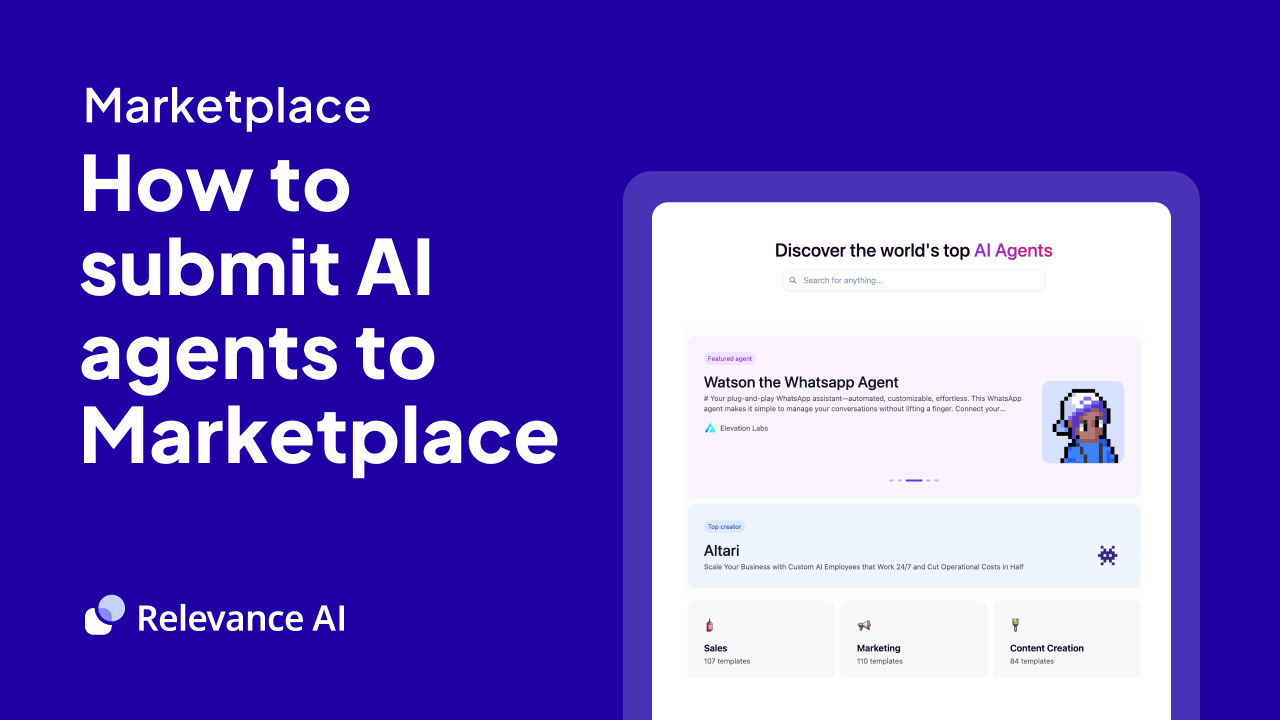Prismic
Understanding Prismic's Headless CMS Platform
Prismic stands as a powerful headless CMS platform that separates [content management](https://relevanceai.com/agent-templates-tasks/content-creation-ai-agents) from presentation layers. The system enables teams to create, manage, and distribute content across multiple channels while maintaining consistent structure and quality. Its API-first approach makes it particularly well-suited for modern web applications and digital experiences.
Key Features of Prismic
- Flexible content modeling that adapts to specific business needs
- API-driven architecture supporting multiple frontend frameworks
- Rich text editing capabilities with customizable components
- Version control and content scheduling
- Multi-language support for global content operations
- Advanced asset management capabilities

Benefits of AI Agents for Prismic
What would have been used before AI Agents?
Content teams working with Prismic traditionally relied on manual processes and multiple human touchpoints to manage their headless CMS workflows. This meant content creators spent countless hours formatting content, checking consistency across pages, and ensuring proper metadata implementation. Development teams had to constantly context-switch between content creation and technical implementation, while content strategists struggled with maintaining brand voice consistency across multiple content pieces.
What are the benefits of AI Agents?
AI Agents transform the Prismic [content creation](https://relevanceai.com/agent-templates-tasks/content-creation-ai-agents) ecosystem in several fundamental ways:
- Intelligent Content Structuring: Digital teammates analyze existing content patterns and automatically suggest optimal content models and structures, reducing the technical overhead for both content and development teams.
- Smart Content Validation: The AI performs real-time checks on content quality, ensuring adherence to brand guidelines, SEO best practices, and accessibility standards without manual review cycles.
- Automated Metadata Generation: Instead of manually crafting meta descriptions and alt text, AI Agents generate SEO-optimized metadata that accurately represents the content while maintaining search engine visibility.
- Dynamic Content Relationships: AI Agents identify and suggest relevant internal linking opportunities and content relationships, creating a more interconnected and valuable content ecosystem.
- Multilingual Content Support: The AI handles nuanced content localization, maintaining context and brand voice across different languages and markets while reducing the need for multiple translation vendors.
The network effects are particularly powerful here - as AI Agents learn from each content iteration, they become increasingly adept at understanding brand voice, content patterns, and user engagement signals. This creates a compounding advantage for teams using Prismic with AI Agents, as their content operations become more refined and efficient over time. [Content strategists](https://relevanceai.com/agent-templates-roles/content-strategy-manager-ai-agents-1) can leverage these insights to make data-driven decisions about content direction and optimization.
Potential Use Cases of AI Agents with Prismic
Content Creation and Management
Digital teammates integrated with Prismic transform how teams handle content operations. They analyze existing content structures, suggest optimizations for content models, and help maintain consistency across the content repository. When editors need to create new content types or modify existing ones, AI agents provide data-driven recommendations based on historical content performance and user engagement patterns.
SEO and Metadata Enhancement
The AI agents scan through Prismic content entries and generate [SEO](https://relevanceai.com/agent-templates-tasks/seo-optimization-ai-agents)-optimized metadata, titles, and descriptions. They analyze search trends and competitor content to suggest keyword opportunities while maintaining the brand's authentic voice. This systematic approach to SEO ensures content discoverability without compromising editorial quality.
Content Quality Assurance
Digital teammates act as quality control specialists, reviewing content before publication. They check for brand voice consistency, grammatical accuracy, and adherence to content guidelines. The agents flag potential issues like broken links, missing alt text, or inconsistent formatting across different content types.
Workflow Optimization
AI agents monitor content creation patterns and identify bottlenecks in the publishing process. They analyze time spent on different content tasks and suggest process improvements. For teams working across multiple projects, the agents help prioritize content tasks based on deadlines and resource availability.
Asset Management
Digital teammates excel at organizing and tagging media assets within Prismic. They analyze images and videos to generate relevant tags, making asset discovery faster. The agents also monitor asset usage patterns and suggest opportunities for content repurposing across different channels. [Asset Management](https://relevanceai.com/agent-templates-tasks/template-management) becomes streamlined through intelligent categorization and automated workflows.
Content Performance Analysis
AI agents track content performance metrics and provide actionable insights. They identify patterns in successful content pieces and suggest ways to replicate that success. The agents also flag underperforming content and recommend optimization strategies based on data-driven analysis.
Localization Support
For teams managing multi-language content, digital teammates streamline the localization process. They help maintain consistency across different language versions, flag cultural nuances that need attention, and ensure proper content structure across all localized versions.
These use cases demonstrate how AI agents enhance content operations in Prismic, making content teams more efficient and effective in their daily work.

Industry Use Cases
AI agents in Prismic represent a significant shift in how different sectors approach [content management](https://relevanceai.com/agent-templates-tasks/knowledge-base-management-ai-agents) and digital experiences. The integration of these digital teammates into Prismic's ecosystem creates unique opportunities across multiple industries, each with its own distinct advantages and applications. From media companies managing vast content libraries to e-commerce brands crafting personalized product narratives, the impact is both profound and measurable.
The real power lies in how these AI agents adapt to industry-specific challenges. They don't just perform tasks - they learn from industry patterns, understand sector-specific terminology, and evolve alongside business needs. This level of specialization means that whether you're in healthcare publishing or running a tech blog, the AI can speak your language and understand your content goals.
Looking at specific industries, we see patterns emerging where AI agents are transforming traditional content workflows into dynamic, intelligent processes. These aren't theoretical applications - they're real-world solutions being implemented by companies right now, driving tangible results and setting new standards for content operations.
Media Publishing: Transforming Content Operations with Prismic AI
Digital publishing teams face intense pressure to produce high-quality content at scale while maintaining editorial standards. The Prismic AI Agent serves as a digital teammate that enhances the capabilities of media organizations through intelligent content operations.
When integrated into a newsroom's Prismic CMS workflow, the AI Agent can analyze incoming content submissions, evaluate them against style guidelines, and provide specific recommendations for improvements. For example, when an editor uploads a draft article about quarterly earnings reports, the Agent automatically checks for financial accuracy, suggests relevant internal links to past coverage, and ensures consistency with the publication's tone of voice.
The real power emerges in breaking news situations. As [reporters](https://relevanceai.com/agent-templates-roles/field-sales-representative-ai-agents-1) file stories from the field, the Prismic AI Agent can simultaneously fact-check claims against trusted sources, surface relevant archive content, and generate appropriate meta descriptions - all while the editorial team focuses on crafting compelling narratives. This parallel processing capability helps news organizations be both first and factually accurate.
Beyond article creation, the Agent optimizes [content distribution](https://relevanceai.com/agent-templates-tasks/social-post-scheduler) by analyzing audience engagement patterns across different platforms. It can dynamically adjust content presentation, from headline variations to image selection, based on real-time performance data. This ensures that each piece reaches its maximum potential audience while maintaining editorial integrity.
The measurable impact on publishing operations is significant: Media organizations using Prismic AI Agents report up to 40% faster content production cycles and a 25% increase in audience engagement metrics. More importantly, they're able to maintain consistent quality while scaling their content output - a critical advantage in today's digital media landscape.
E-commerce: Scaling Product Content Creation with Prismic AI
Growth-minded e-commerce teams often hit a content bottleneck when expanding their product catalogs. The Prismic AI Agent fundamentally changes this dynamic by functioning as a specialized digital teammate focused on product content optimization.
The most compelling aspect lies in how the Agent handles [product description creation](https://relevanceai.com/agent-templates-tasks/landing-page-copy-generator) at scale. When merchandising teams upload new inventory data, the AI analyzes product specifications, market positioning, and brand voice guidelines to generate rich, SEO-optimized product descriptions. For instance, a fashion retailer launching a new seasonal collection can have the Agent create hundreds of unique product descriptions while maintaining consistent brand storytelling across categories.
A critical growth lever emerges in the Agent's ability to dynamically personalize product content based on user segments and traffic sources. The AI continuously analyzes purchase patterns and engagement metrics, then adjusts product descriptions, feature highlights, and social proof elements to resonate with specific customer cohorts. This creates a network effect where each customer interaction improves the system's ability to convert future visitors.
The Agent also excels at maintaining [content maintenance](https://relevanceai.com/agent-templates-tasks/knowledge-base-updater) across large catalogs. It monitors competitor pricing, tracks inventory levels, and automatically updates seasonal messaging - tasks that would typically require significant manual effort. This automated content maintenance ensures product pages remain relevant and competitive without constant human intervention.
Data from early adopters shows the network effects in action: E-commerce sites using Prismic AI Agents see an average 32% increase in product page conversion rates and a 45% reduction in content production costs. The compounding benefits of automated, personalized content creation make this a powerful tool for e-commerce brands focused on sustainable growth.

Considerations for Prismic AI Implementation
Implementing AI agents within Prismic requires careful planning and strategic consideration of both technical architecture and operational processes. The integration touches multiple aspects of content operations and requires thoughtful execution to maximize value while minimizing disruption.
Technical Considerations
Content model adaptation stands as a critical first step. The existing content structures need evaluation and potential restructuring to accommodate AI-driven workflows. This includes:
- Modifying content types to include AI-specific metadata fields
- Establishing clear taxonomies that AI can interpret accurately
- Creating fallback mechanisms for when AI processing fails
API integration patterns require particular attention. Teams must determine optimal approaches for:
- Managing rate limits and concurrent requests
- Handling authentication and security protocols
- Implementing retry logic for failed API calls
Operational Considerations
Content workflow redesign becomes necessary when introducing AI capabilities. Teams need to address:
- Training [content editors](https://relevanceai.com/agent-templates-roles/content-strategy-manager-ai-agents-1) on new AI-enhanced processes
- Establishing quality control checkpoints for AI-generated content
- Creating escalation paths for complex content decisions
Governance frameworks require updates to account for:
- Content ownership and attribution policies
- Version control strategies for AI-modified content
- Audit trails for AI-driven changes
Performance Monitoring
Measuring AI impact demands robust analytics tracking:
- Content quality metrics before and after AI implementation
- Processing time improvements
- Error rates and resolution times
- User adoption and satisfaction levels
AI-Enhanced Content Management: A New Era
The integration of AI Agents with Prismic marks a significant evolution in [content management](https://relevanceai.com/agent-templates-tasks/content-calendar-automation) systems. These digital teammates don't just automate tasks - they fundamentally enhance how teams create, manage, and optimize content. The network effects generated through continuous learning and optimization create lasting competitive advantages for organizations. As content demands continue growing, the combination of Prismic's robust CMS capabilities with AI-driven intelligence positions teams for sustained success in their content operations.











